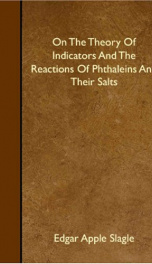on the theory of indicators and the reactions of phthaleins and their salts

The author takes pleasure in expressing his gratitude to President Remsen, Professor Morse, Professor Jones, Professor Ames, Professor Renouf, Associate Professor Acree and Dr. Gilpin, for instruction in the class room and laboratory. Especially does he wish to express his sincere gratitude and thanks to Associate Professor Acree, under whose personal direction this investigation has been pursued. On the Theory of Indicators and the Reactions of Phthaleins and Their Salts The rapid advance in our knowledge of the constitution and reactions of colored compounds of the aromatic series has made it clear that we must seek the cause of the manifestation of color in some deep-seated change in the molecule itself. The view formerly held that the color of these particular benzene derivatives is a function only of the increase in the molecular weight, or depends upon the introduction of certain elements or groups which tend to produce color, has long been abandoned. The first important attempt to formulate a theory of color is seen in the hypothesis of 0. N. Witt, l brought out in 1876, in which he assumed in all colored compounds the presence of certain specific groups nitro, azo cyan, etc. which were thought to be responsible for the color. Witt called these groups chromofihores. - He recognized in some cases the additional influence of certain salt-forming groups hydroxyl, amino, etc. which intensify the color of the chromophore 1 Ber, d. chem. Ges.. 9, 522. and give to the compound the properties necessary in making the dye practically useful. These latter, groups were called azcxochromes. The quinone theory was first advanced by E. and 0. Fischer to explain the coiors of the dyestuffs of the rosaniline series and is really an extension of Witts, which gives a more definite meaning to the term chromophore. In 1889 Nietzkil extended the quinone theory, using, however, the modern formula of quinone, to the indamine and azine series. This conception was shortly after extended by Armstrong to include all colored compounds of the aromatic group. In 1893 Friedlander2 assigned a corresponding quinone structure to phenolphthalein salts. He accepted Baeyers formula for phenolphthalein in the free condition, but assumed that an intramolecular change takes place in the molecule in the presence of alkalies which results in the formation of the colored quinone salt, NaOOCC, H4C C, H4 0 C, H, ONa, which he assumed to be analogous to the salts of aurin, NaOC, H,, C C, H4 0, - and of rosolic acid, 8 NaOC, H4 0 C, H, C C, H, CH, ONa. As a proof of the existence of the quinone structure in the salt KOOCC, H4 C C, H, 0 C, H, OK , he prepared an oxime by treating an alkaline solution of phenolphthalein with hydroxylamine. Friedlander also suggested that phenolphthalein is a dibasic acid and that the salts are dibasic salts, but it remained for Meyer and SpenglerS to prove 1 Organische Farbstoffe. 1st Edition, p. 2. 3 Ber. d. chem. Ges., 26, 172. 3 Ibid.. 38, 1318...
Info about the book
Author:
Series:
Unknown
ISBN:
3867412561
Rating:
3/5 (2)Your rating:
0/5
Languge:
English
Users who have this book
Users who want this book
What readers are saying
What do you think? Write your own comment on this book!
write a commentGenre
if you like on the theory of indicators and the reactions of phthaleins and their salts try:
Other books by this author
Do you want to exchange books? It’s EASY!
Get registered and find other users who want to give their favourite books to good hands!

